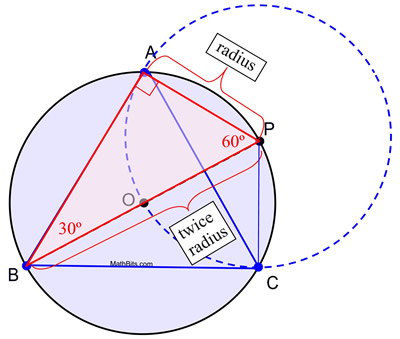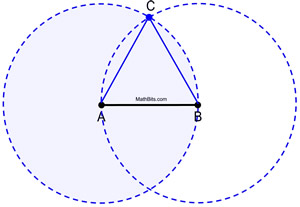Draw Equilateral Triangle Inside Circle
| | Use only your compass and straight edge when drawing a structure. No free-hand cartoon! |
We will be doing 3 constructions of an equilateral triangle. The first will be to construct an equilateral triangle given the length of one side, and the other two will be to construct an equilateral triangle inscribed in a circle.
| Given: the length of 1 side of the triangle | |
STEPS:
1. Place your compass indicate on A and measure the altitude to point B. Swing an arc of this size above (or beneath) the segment.
two. Without changing the bridge on the compass, place the compass point on B and swing the same arc, intersecting with the showtime arc.
3. Characterization the indicate of intersection as the third vertex of the equilateral triangle.
| | Come across the full circles at piece of work. |
Proof of Structure: Circle A is coinciding to circle B, since they were each formed using the same radius length, AB. Since AB and AC are lengths of radii of circle A, they are equal to one another. Similarly, AB and BC are radii of circumvolve B, and are equal to 1 some other. Therefore, AB = Ac = BC by commutation (or transitive property). Since congruent segments have equal lengths, ![]() and ΔABC is equilateral (having three congruent sides).
and ΔABC is equilateral (having three congruent sides).
| Given: a piece of newspaper | This is a modification of the construction of a regular hexagon inscribed in a circle. |
STEPS:
1. Place your compass point on the paper and depict a circle. (Continue this compass bridge!)
2. Identify a dot, labeled A, anywhere on the circumference of the circumvolve to act as a starting point.
iii. Without changing the span on the compass, identify the compass point on A and swing a small arc crossing the circumference of the circumvolve.
4. Without changing the span on the compass, movement the compass point to the intersection of the previous arc and the circumference and make another pocket-sized arc on the circumference of the circle.
5. Keep repeating this process of "stepping" around the circle until you render to indicate A.
6. Starting at A, connect every other arc on the circle to class the equilateral triangle.
| |
Proof of Construction: The proof of the inscribed regular hexagon shows that the central angles of a regular hexagon contain 60º. The primal angles of the triangle inscribed in this circumvolve contain 120º. Since ΔAOC is isosceles (OA and OC are radii lengths), g∠OCA = thou∠OAC = ½ (180 - 120) = 30º. ΔAOC ![]() ΔCOB
ΔCOB ![]() ΔBOA by SAS. Past CPCTC, ∠OCB
ΔBOA by SAS. Past CPCTC, ∠OCB ![]() ∠OCA and m∠OCB = 30º by substitution and 1000∠BCA = 60º. In similar fashion, we have k∠ACB = grand∠CBA = m∠BAC = 60º and equilateral ΔABC.
∠OCA and m∠OCB = 30º by substitution and 1000∠BCA = 60º. In similar fashion, we have k∠ACB = grand∠CBA = m∠BAC = 60º and equilateral ΔABC.
| Given: a piece of paper | This method uses knowledge of the special right triangle 30º - 60º - 90º. |
STEPS:
1. Place your compass point on the paper and draw a circle, O. (Keep this compass span!)
2. Using a straightedge, depict a diameter of the circle, labeling the endpoints P and B.
3. Without changing the bridge on the compass, place the compass point on P and draw a full circumvolve.
four. Label the points of intersection of the two circumvolve circumferences with A and C.
five. Describe segments from A to B, B to C and C to A, to course the equilateral triangle.

Proof of Structure: This construction uses the fact that an angle inscribed in a semicircle is a right angle, and that in a 30º-60º-90º triangle, the length of the short leg is one-half of the length of the hypotenuse. In this construction, circumvolve O and circle P are coinciding since they have the aforementioned radius length. AP is a radius length of circle P and radii AP = OP. OP is too a radius length of circumvolve O (forth with OB) and diameter BP = BO + OP = 2 OP. Past substitution, BP = 2 AP, creating the atmospheric condition necessary for m∠ABP = 30º. Consequently, m∠APB = 60º. A similar argument can be used to establish that for ΔPBC, m∠ PBC = 30º and 1000∠BPC = 60º making ΔPBC ![]() ΔPBA by ASA (with shared side from B to P).
ΔPBA by ASA (with shared side from B to P).
At present, ![]() since they are the corresponding sides of the two congruent triangles, making ΔABC isosceles. ∠BAC
since they are the corresponding sides of the two congruent triangles, making ΔABC isosceles. ∠BAC ![]() ∠BCA since the base angles of an isosceles triangle are congruent.
∠BCA since the base angles of an isosceles triangle are congruent.
grand∠ABC = m∠ABP + m∠PBC = 30º + 30º = 60º past Angle Add-on Postulate and substitution. m∠BAC + m∠BCA + m∠ABC = 180º because the sum of the bending measures in a triangle is 180º. Since m∠BAC + one thousand∠BAC + 60º = 180º by exchange, we know 2g∠BAC = 120º and m∠BAC = 60º. Consequently 1000∠BCA also equals 60º by substitution, making ΔABC equilateral.
![]()
Annotation: The re-posting of materials (in part or whole) from this site to the Internet is copyright violation
and is non considered "fair utilise" for educators. Delight read the "Terms of Utilise".
Source: https://mathbitsnotebook.com/Geometry/Constructions/CCconstructionEqui.html



0 Response to "Draw Equilateral Triangle Inside Circle"
Post a Comment